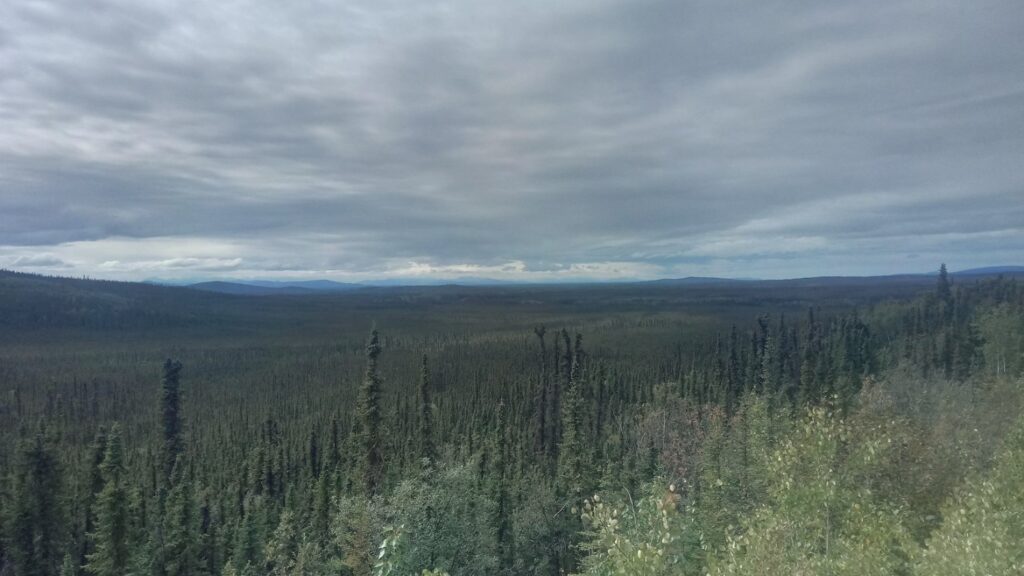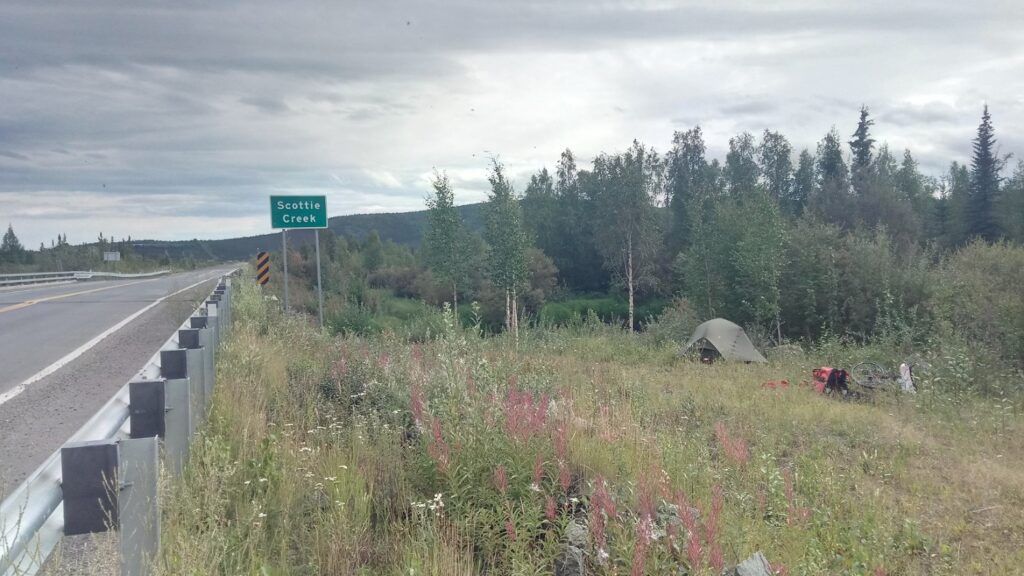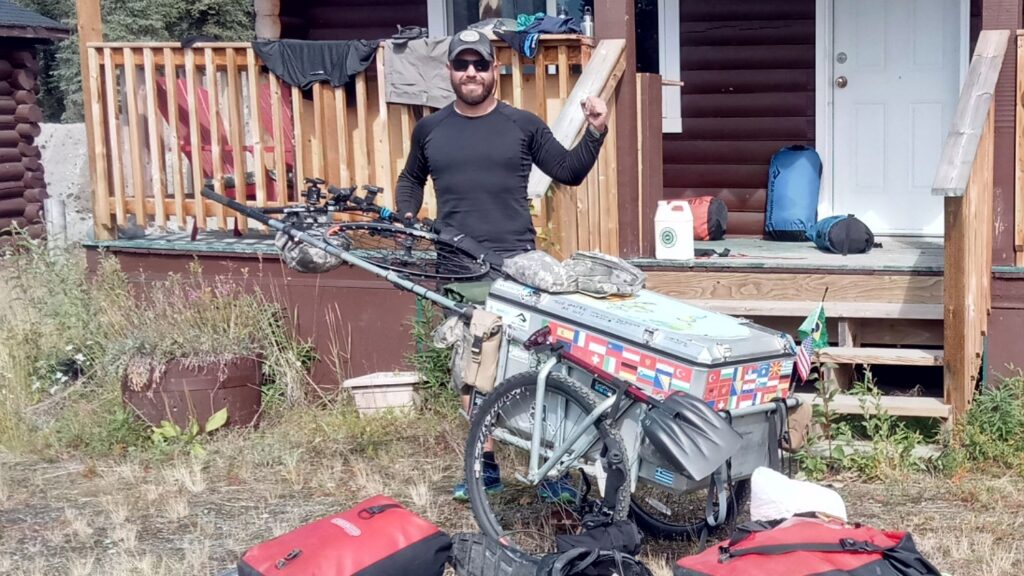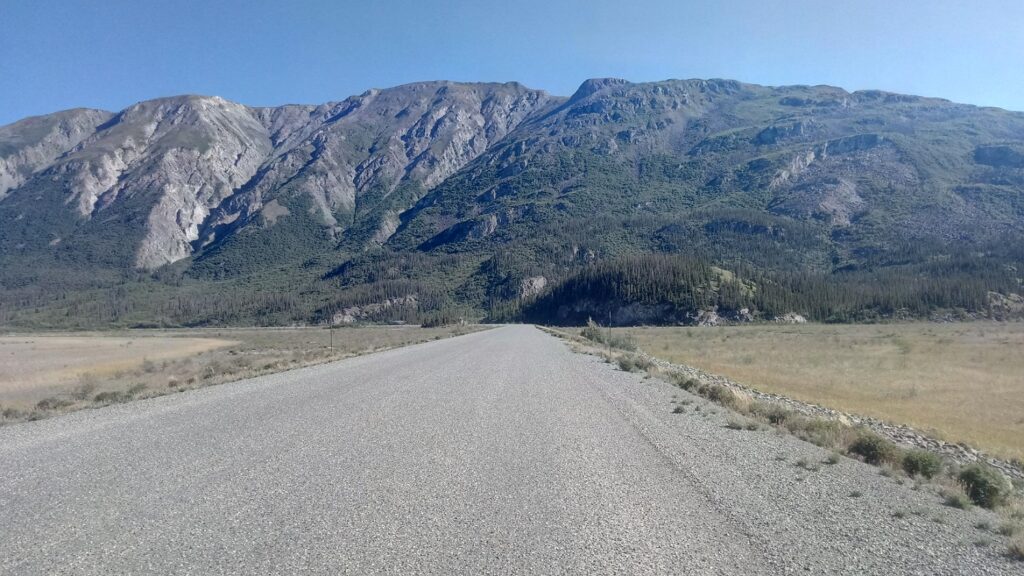Tok isn’t Anchorage.
Tok is what some Americans might call ‘a wide part of the road’.
There is a visitor centre, library, a few campsites and motels, a couple of gift shop/ tourist trap affairs, two gas stations, a motel/launderette/public showers and a medium sized grocery store.
I rolled up to a campsite under maintenance. The owner apologised that he had no showers or laundry facilities to offer, but he could turn the water on for me and there was WiFi.
Only 10 dollars a night. I paid up for three.
I headed into ‘town’ and bought about 5 different kinds of fruit and vegetables.
Still had a largely processed meat and rice based dinner, but with lots of green bits thrown in! Obviously this was all washed down with a suitable beverage…
The next day I did the usual rest day chores: laundry, shower, editing and publishing blog.
Grabbed some more food and beer and plonked down happily with the radio going.
The first night there had been just one other group of campers, a couple in a campervan. For the next two nights I had the place to myself. After living a mostly solitary existence out on the road it wouldn’t have been my chosen state of affairs, but at least the place was cheap.
In order to get into Canada you need to use the ‘ArriveCAN’ mobile app, onto which you upload your documents. Once that is sorted you have to submit your travel plans 72 hours prior to arriving at the border.
It turned out to be stubbornly uncooperative with me. I vented my frustration within earshot of the staff at the visitor centre and they directed me to the library with its bank of PC’s. The librarian received me with ‘oh, another one!’
I found myself sitting next to a local guy, James (name changed, since Tok is a small place).
Within 10 seconds of chatting to me he declared himself an alcoholic.
He used to take prescription painkillers, but switched to drink instead.
Apparently his doctor had just diagnosed him as having liver failure.
James felt blindsided by the outpouring of support he had received from friends and family in response to the news. He never knew they cared so much.
He showed me his girlfriend, sister and three kids on Facebook and we talked about our respective loved ones.
He had tried to get a job, but they had pegged him as being a drunk and turned him down, even though he remained sober long enough to pass a urine test.
Apparently working at a lumber yard was a possibility, but they tend to pay cash in hand, and therefore don’t contribute towards health insurance.
He dreamed of being able to travel, but needed a way to earn the money for it.
I tried my best to steer the conversation in a positive direction and encouraged him to keep going with the sobriety, but after a few minutes he brought out a large bottle of rum from his rucksack, and started drinking right there in the library.
By the time I had sorted out my bits and pieces he was drooling slightly and his eyes were unfocused.
As I left he invited me to stay with him in his tent, but I made my excuses and headed out.
Unfortunately alcoholism and opioid abuse disproportionately affects people of First Nation origin in Alaska. Consequently, most of the native communities I’ve passed display signage at their entrance banning alcohol, enforced by law.
Having apparently won my battle with ArriveCAN, I started pedalling down the legendary Alaska Highway (Alcan) towards the Canadian border at Beaver Creek, 107 miles away.
Lots of motorised tourists warned me that the road was in atrocious condition. They made it sound like there would be apocalyptic gaping fissures in the road, waiting to swallow up a wayward traveller.
A few miles out of town I saw a sign stating ‘Road damage ahead’. Underneath someone had written ‘No shit’.
There were intermittent stretches of gravel up to a few miles long. It got pretty dusty when vehicles came by.
The tarmac sections were often pretty badly potholed.
Not something your car or RV wheels want to smash into at 50 mph, but for a cyclist it was just a bit of a slalom.
The only real challenge was descending at speed and ensuring I didn’t swerve unknowingly into overtaking traffic.


The lack of much human contact over the last few days, combined with the knowledge that this situation wasn’t likely to improve for at least a week, began to erode my enthusiasm.
Am I really enjoying this experience or am I only riding for the sake of ticking something off the bucket list?
Whenever the negative waves hit me and I start flagging, I seem to almost immediately meet someone on the road who inadvertently reaffirms my purpose.
Such was the case this time.
I ran into Carolina and Rodrigo, an Argentine couple who had cycled all the way from their home.
It took them six years to get to Alaska, including a pandemic induced break working in the Caribbean for three years.

The next day I met Cooper, an American who had pedalled up from Montana.
He was about to finish his four weeks of riding in Fairbanks.
Probably the friendliest cyclist I’ve met so far. We shared stories and swapped information about each other’s bit of road ahead.
Camped just before the US customs post at the edge of Alaskan territory.
Bizarrely, Canada-bound traffic crosses into Yukon Province, Canada, 20 miles before actually going through Canadian customs.

After spending 40 days in the ‘Last Frontier’, it was finally time to leave.
The people really make Alaska.
No matter how disgusting I must have looked or smelled, I was always treated with respect and generosity.
I took my time pedalling as much of the state as possible, thinking I would likely never see it again.
Instead I’m convinced I will be coming back, if only to try and catch a salmon to see what all the fuss is about…
Before crossing into Canada, I met Jim, who owns a motel/ RV park.
Jim tends to get a lot of overlanders coming down the Alcan, so he had loads of stories.
He was happy to tell me that he once got stuck in a blizzard in mid-August down at Haines Junction, where I expected to be by the middle of August… Thanks Jim.
Got into Canada without issue and continued for the remaining 30 miles to my rainy camp by the White River.


Probably the coldest night in the tent so far. I couldn’t feel my feet after being in wet shoes, so I did quite a bit of extra pedalling in my quilt before settling down.
I might have made the mistake of picking a too-obvious camp site. I was next to a lay-by which enabled people to stop and look at the river.
I got quite a few visitors through the evening. At one point a dog ran around my camp and left some presents in the grass for me to discover the next morning.
It started out cold and damp the next day. Rapidly lost sensation in my feet again despite wiggling my toes furiously. I had thick, dry socks with plastic bags over them, but my shoes were soaked. The evaporation was cooling my feet down regardless.
Got out of there as rapidly as possible. Begged some water from a hosepipe at a nearby RV park and carried on.
The sun came out, but the road turned to gravel. Fair trade, the harder I work the warmer I get…


Halfway through the day I spotted a trolley covered with flag stickers beside a cabin, where a load of clothes were hanging out to dry. Did I detect another soggy overlander?
Matias Tartiere is walking to Ushuaia.
He started at the very top, from Deadhorse, like me.
He’s already walked across Europe, but COVID kept delaying this particular journey.
By the sound of it he previously walked all the way down from the Dalton, only to be turned away at the Canadian border.
Now he has picked up where he left off and is determined to get the job done.
Matias reckons he should arrive in two years. He’s doing about 15.5 miles/ 25km per day.
He laughed about how travelling on a bicycle is like watching a movie, but walking across a continent is like reading a book.

Apparently the cart weighs 135 kilograms / 297 pounds when it has a full load of food and water. Imagine pushing the weight of one and half grown men up a hill!
Here is a video from his YouTube channel where he tackles the Dalton Highway.
What a man!
When I spoke to him he was in the middle of breaking camp and needed to get a move on.
He confessed it takes him about two hours to get everything squared away before rolling. It’s usually about the same for me.
Carried on about 15 miles further and got some fantastic views of the St Elias mountains.
The legs were getting a bit heavy, so I decided to plonk down the tent at about mile 40.
Rubbish day for mileage but I figured I could crack a beer and take in the view.
Rolled the bike off the side of the road onto a ledge, took the panniers off, opened a tinny and admired the scenery.
Heard a weird sound. My brain wasn’t working particularly rapidly after a day of pedalling, so I took a moment to process it.
Sounded a bit like a big dog panting. Didn’t see any place a dog could have come from though. What might make that sort of noise? A bear maybe? Is there a bear right behind me?
I turned around slowly.
There was a brown bear standing on its hind legs behind me.
After scaring the bear away I decided that the best course of action was to get the hell out of there. Unfortunately the road headed into the wind, so any cooking odours from camp would be blown back towards my new best friend.
Made it to a rather nice riverside spot with an otter swimming along it. This will do!

Fortunately I didn’t experience any furry visitations during the night.
The next day I pedalled alongside the Kluane river, heading up a wide valley with mountains on either side.
A sturdy wind blew down the valley, right in my face.
Front panniers, a pair of walking boots hanging on the bars and being a relatively wide shouldered rider gave me all the aerodynamics of an apartment block.
My average speed dropped down to about 7 mph and I found myself having to pedal down hills, which is always a bit dispiriting.
I passed through a bit of civilization in Burwash Landing and Destruction Bay.


Put the tent down with a nice sheltered view of Kluane Lake.
I wasn’t in a rush to get going the next day. Pretty much just hung around the lake shore for all of the morning.
Set off for a pretty aimless ride around the lake shore.

I stopped at the trail to ‘Soldiers Summit’, where the Alaska Highway had been completed.

Construction of the highway had been carried out in two separate sections, one originating in Canada and the other in Alaska.
When Pearl Harbour was attacked, it sparked fears that the Japanese could easily invade the mainland United States through Alaska.
At this stage the only way into Alaska was by ship, through ports like Valdez and Skagway.
This led to the ‘Alcan military road’ being commissioned in 1942, to enable men and material to be brought up from the lower 48 states through Canada.
Costing 130 million dollars, It was the single most expensive project undertaken in World War Two.
A workforce of 10,000 troops was brought in by the Army, doubling the population of Yukon Province.
One third of the soldiers were African-American, mostly from the warmer southern states.
Their superiors were prejudiced against the idea of blacks being able to use heavy machinery.
One soldier’s account told of how they weren’t allowed to leave the army base in Skagway, because the higher ups didn’t want African-American’s mixing with the local population in the town.
During construction temperatures dropped down to -40°C / -22°F in winter, while swarms of mosquitoes caused untold suffering in the summer months.
In winter engines had to be left running all night, otherwise they couldn’t be started again until thawed out with a blowtorch.
Small mistakes could be very costly.
There was an account of a soldier who accidentally spilled petrol on himself.
It evaporated, instantly freezing his skin, which peeled off when he touched it.
On stretches of muskeg, a peaty bog ecosystem, removing the top soil exposed permafrost to warmer air, causing it to thaw.
A hard surface would rapidly turn into a mud bath, hopelessly bogging down construction machinery.
The solution was to insulate the permafrost by cutting local trees down and using them as a blanket, upon which the gravel road could be built.
This limited the pace of construction to how rapidly trees could be felled.
1500 miles of rough road was completed in just 8.5 months.
It was opened to the public as ‘The Alaska Highway’ in 1948.
Nowadays the Alcan is often compared to the Panama Canal in terms of the magnitude of the task carried out.
While the highway opened the door to rapid development of the previously isolated State of Alaska, the impact upon First Nations communities along its route was perhaps even more substantial.
Prior to the road being constructed all transportation was dog powered: dog sleighs were used in winter and in summer pack dogs could be used to haul luggage.
Now automobiles were available to provide transportation. Children from previously isolated communities could be taken to school in buses.
There were widespread outbreaks of communicable diseases such as measles and tuberculosis, brought in by infectious soldiers.
Access by road also enabled direct control by the Canadian government.
The ‘Indian Act’ meant that Dän (people) could not legally vote, hold property or own a business. They had become second class citizens in their own land.
Many schoolchildren were sent to residential schools, while others were confiscated and adopted out to guch’an (non-native) parents.
Overhunting by the increased human population led to the Canadian Government creating the Kluane Game Sanctuary, banning hunting in the region.
This applied equally to Dän who had hunted and trapped in the area for thousands of years before guch’an arrived.
At a stroke their traditional lifestyle of subsistence was gone. They were left with the choice of either taking paid jobs provided by the influx of modern technology, or leaving their ancestral homelands for less developed places.
It took four decades of campaigning before Dän could hunt in Kluane again.
There is still a lot of work to be done to correct past mistakes made in the name of economic development.
After the historical side trip I returned to my slow progress into the wind.


Overall I only managed about 27 miles to a place called Sulphur Creek.
Perhaps not the best name for your water source.
I spotted an otter swimming around, so hopefully not too toxic?
The next day I made it to Haines Junction. Messaged a few Warmshowers hosts as I was getting close to Whitehorse and needed someplace to stay.
I wouldn’t be able to check the internet again until I arrived there, so it was a bit of a shot in the dark.

Having turned the corner at the junction the wind was finally out of my face and I marvelled at how easily the bike rolled along.
After a couple more days of gently undulating road, I pedalled into town.

I went directly to McDonald’s; It’s dependable for free WiFi and you can arrive scruffy and dirty without getting turned away. Moment of truth, did I have a place to stay?
….if you can get hold of couscous or bulgar wheat – both are healthy (esp the latter) and both simply need to be soaked for ten minutes in boiling water (ie. Boil water, pour it over and then leave it, so saves on fuel as well.
Talk about leaving us on tenterhooks….!
Just brought Gran home from respite home in Dersingham.
Juliaxx
That is precisely what I’m looking for, thanks! I’ll see if I can find a nice cheap bag of either at my next top up. Send my regards to Gran I hope she’s feeling better.
I had just come into comments to tell you to get couscous! Julia beat me to it. Check out the pasta aisle too as some smaller ones you’ll be talking a couple of minutes to boil.
Bon appetit!
Alright! Well when I get info from another traveller about a given road or something, I like it if I get multiple data points so I can see some kind of common trend. It sounds like Couscous is the way 😀 Thanks Soph!
A fascinating blend of geography, history, and the natural world!! Particularly struck by your empathy for the sockeye salmon, although I guess that if one leapt into your pan you might be able to suppress any feelings of guilt … As for the bear – we’re still trying to work out whether the high pitched bleeps represent a means of bear scaring, or were inserted to delete words and phrases designed for the ursine ears only!
Hope the beard doesn’t follow genetic precedent and end up making you look like a marmoset.
I’ve already managed to break a comb. It was an ex-soviet army surplus one I got in Helsinki. You know you have grooming problems when that happens….
Also, when you can, put a squeeze of lemon in your cous cous. Perks it up no end and will keep your anti scurvey defences up. Also a great vehicle for dried fruits like apricots in a meal 🙂
Sounds like I’m already halfway to a tagine if I start chucking dried fruit in 🙂 I’m working my way through a 2kg bag of rice, but will be sure to swap over when the opportunity arises. Lemon should keep pretty well in a pannier hopefully….?
You know, there is something rather surreal about all this talk of gourmet eating in the context of your journey…. Before long you are going to start dreaming of food…
J
Dave that ship sailed a long long time ago….
I almost cried when I found Marmite and Yorkshire tea on the shelves in Whitehorse.